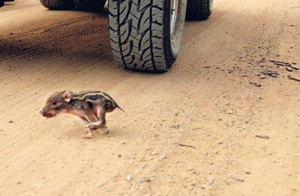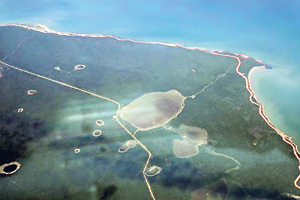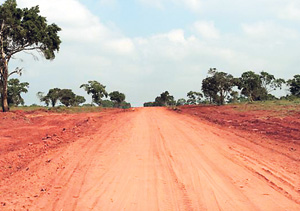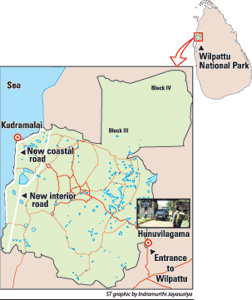The heart-rending sight of a vulnerable wild piglet near the massive tyres of vehicles rushing past tells Wilpattu’s tale in all its tragedy.
Did the little one survive or was it crushed to a pulp and left only as a small patch on a new huge interior road where civilian traffic is plying to and fro at breakneck speed? The piglet had not strayed on to a busy highway close to a city, town or even in a rural area, but was in its own “protected home-ground”.
If the plight of the piglet is this, what of the other animals the Wilpattu National Park is famous for with all types of vehicles whizzing through, without the permits and the trackers compulsorily required in any National Park?
 |
A terrified wild piglet just misses the monstrous wheels of a
vehicle plying the interior road |
In the light of these developments, strict guidelines on the dos and don’ts at this National Park have been clearly spelt out by its custodian, the Department of Wildlife Conservation (DWC) after its re-opening on February 27.
Halt civilian traffic along the new road and stop work on a partly-built road hugging the coastal boundary of the National Park, the DWC has told both the Ministries of Defence and Highways through the Ministry of Environment, a high-level source told the Sunday Times.
This is after DWC officials were able to access the National Park, after de-mining operations were completed by the security forces, on February 27 and check out what has been going on at Wilpattu, the source said.
The DWC action came as five key environmental organizations sent a letter to President Mahinda Rajapaksa expressing serious concerns over the happenings at Wilpattu.
The rape of unique Wilpattu, the largest National Park in the country covering 131,694 hectares, has begun with these new roads, the Sunday Times understands.
Wilpattu in the northwest has it all – a spectacular and pristine landscape, high cliffs sloping down to the sea; animals such as the sleek leopard, the elusive sloth bear and the majestic sambhur not to mention elephants; tall stark trees, burutha, weera and palu rising up to the skies; and also archaeological treasures (Prince Vijaya is believed to have landed along Wilpattu’s coast).
 |
| Wilpattu was the best place in the world to see leopards, the Sunday Times understands while “photos of leopards on the white sands” of the National Park
are legendary |
 |
| Aerial view of the roads |
“A deadly precedent,” is how a conservationist strongly described the construction of these roads, explaining that such activity will not only lead to an onslaught on Wilpattu but also the destruction of other National Parks. Fears abound that the two roads, allegedly constructed without the mandatorily required permission of the DWC under the Fauna and Flora Protection Ordinance, are the first step in the rape of this remarkable landmark, another conservationist said.
Unhindered poaching and illicit felling of timber dubbed “kelle business” in the area, destruction of the unique villu ecosystem found nowhere else in this country and the fragmentation of this National Park are but a few of the fallouts of this road-building exercise, along with the danger of road-kills adding to the woes of the wild creatures. It will also facilitate the easy transport of contraband from north to south, the Sunday Times understands.
The confusion over the road issue has been confounded by rumours and speculation, another source pointed out, explaining that some are talking about the “development of the A 32” while others are referring to the “Old Mannar Road”.
Spreading a large Sri Lanka map, this conservationist clearly pointed out the A 32 which is well north of Wilpattu, away from the National Park, and connects Mannar to the Jaffna peninsula. Referring to the Old Mannar Road, he explained that it had been just a track, overtaken by the jungle in sections and in disuse over the past 100 years.
What have been created now are two huge roads, which are “illegal, serious and a systematic abuse of Wilpattu”. The first, a nearly 35-km road cuts across the National Park from the southern boundary at Illuvankulam to Pukulam on the northern boundary, seriously damaging several villus.
Meanwhile, the second road, another source points out is even wider than the first, winding its way from the south of the National Park, hugging the coastline, and then swinging inland at Kudramalai Point on the north.
Before this atrocity, civilians could access Wilpattu whenever the National Park was opened only from its eastern boundary, turning off from Nochchiyagama and gaining entry at Hunuwilagama.
Speculation is rife about why the roads have been built. One may be for security reasons, another to cut short the time taken to reach the northern points such as Mannar and Jaffna and the last to establish a tourist resort along the Wilpattu coastal belt, according to what conservationists have heard.
Dealing with the “security” aspect, a conservationist lamented that the war was won without any destruction of Wilpattu but now the onslaught on the National Park had begun. Aren’t the base and infrastructure at Anuradhapura adequate and can’t the sea off Wilpattu be kept under surveillance from Kalpitiya, another queried.
On the excuse that the roads through the National Park are meant to reduce the time taken to reach the north (Puttalam-Mannar or Colombo -Jaffna), another environmentalist points out that skirting Wilpattu and using the Nochchiyagama-Nikewewa-Tantirimale-Cheddikulam Road would only add about 40 km to Mannar while the distance along the A 9 from Colombo to Jaffna is only 8% more than through Wilpattu.
As vehicles moving at high speeds cannot be allowed through National Parks, if the maximum speed is only 20 or 30 km/hr, “shorter” on a map will not mean it would take less time to go from A to B, another argued. “It would be far better to develop the road round Wilpattu into a highway instead of passing through the National Park and destroying the last bits of nature we have,” he said.
Referring to the proposed tourist resort, the source stressed that divesting the area from a conservation agency (in this case the DWC) and developing it for tourism would have disastrous consequences.
 |
| One controversial road: For whose benefit? |
The country’s coastline covers about 1,700 km and Wilpattu with 35 km of coast, Bundala with 20 km and Yala with 70 km add up to only about 125 km.
The total coastline in its natural state is only 7% and with the other 93% having already been developed or open to development, can’t we let the balance, including that of Wilpattu, be in its natural state, a conservationist asked.
“Yes, Wilpattu is a tourist attraction not only for foreigners but also for locals and its character should be retained and rules and regulations enforced to maintain this status,” he said, adding that it is a “natural national treasure” which should be protected for future generations.
What is stated in The Fauna and
Flora Protection Ordinance
The Fauna and Flora Protection Ordinance is clear as crystal, says environmental lawyer, Jagath Gunewardena, underscoring the fact that “entering a National Park, constructing roads within it, destroying of wildlife habitats, constructing permanent bridges, felling and removal of trees, making excavations and separating and fencing forest land have all been done in clear violation of Sections 3 and 6”.
Meanwhile, Section 5 stipulates that no one can enter a National Park except to observe and study wildlife and for recreation purposes. Therefore, letting people use roads through a National Park is an offence, he said.
Pointing out that now Wilpattu National Park has been handed back to the DWC and falls under the FFPO, Mr. Gunawardena says during times of national crisis, the National Security Act overrides the normal laws of the land. “We knew about the construction of the interior road during the last stages of the war, but kept quiet because of patriotism and in the national interest. But now using that same road for civilian transport is illegal,” he added.
Plea to President
‘Intervene’, they have urged President Mahinda Rajapaksa in a letter sent on March 3, to prevent a national tragedy at Wilpattu.
Detailing all their concerns, the Wildlife Nature Protection Society, the Sri Lanka Nature Forum, the Ceylon Bird Club, Environmental Foundation Limited and the Young Zoologists’ Association have earnestly requested President Rajapaksa to take action to stop this act of destruction and express confidence that he will do so. |






